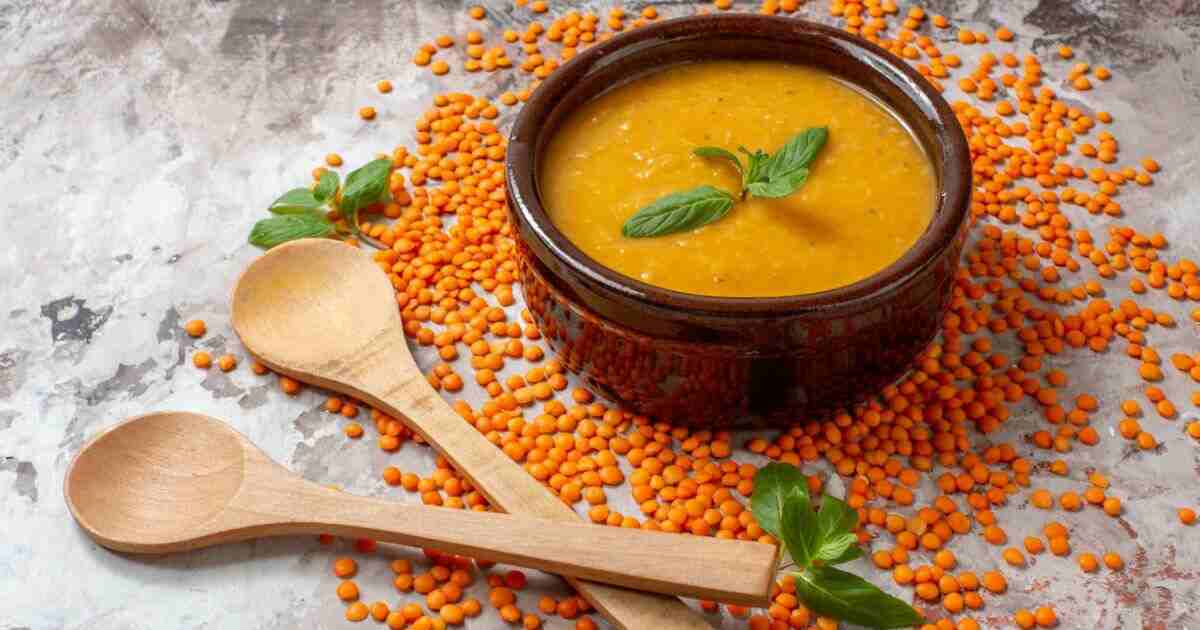Yellow lentils are a nutritious source of plant-based protein and fiber. One cup of cooked yellow lentils provides around 230 calories, 38 grams of carbohydrates, 18 grams of protein, and 1 gram of fat.
Lentils are some of the oldest cultivated crops in the world, and remain a popular staple food in many cultures. Yellow lentils, also known as chana dal or split bengal gram, are a type of pulse that have a slightly sweet, nutty flavor and a buttery texture.
These lentils come in various forms, including whole, split, and pre-cooked, and can be used in a range of dishes such as soups, stews, salads, and curries. In addition to their high protein and fiber content, yellow lentils are also rich in nutrients like iron, magnesium, and folate, which are important for maintaining overall health and preventing chronic diseases.

Credit: www.truvitals.in
What Are Yellow Lentils And Why Should You Care?
Yellow lentils are a versatile and nutritious legume that have been a staple in many cultures for centuries. These tiny beans are a rich source of protein, fiber, and other essential nutrients. In this blog post, we will explore why you should care about yellow lentils, their benefits, their popularity in different cultures, and how to cook them at home.
A Brief Introduction To Yellow Lentils
Yellow lentils, also known as moong dal in indian cuisine, are small yellow beans that are part of the legume family. They are native to india, but are now grown and consumed worldwide. Yellow lentils are a popular ingredient in indian, middle eastern, and african cuisine, and are commonly used in dishes such as soups, stews, and curries.
Why Yellow Lentils Are A Superfood
Yellow lentils are a nutrient-dense food that is packed with health benefits. Here are some reasons why yellow lentils are considered a superfood:
- Protein: Yellow lentils are an excellent source of plant-based protein, which is vital for building and repairing tissue in the body.
- Fiber: Yellow lentils contain a high amount of fiber, which aids in digestion and keeps you feeling full for longer.
- Vitamins and minerals: Yellow lentils are rich in essential vitamins and minerals, including folate, iron, magnesium, and potassium. These nutrients help maintain a healthy immune system, protect against disease, and support overall well-being.
- Low in fat and calories: Yellow lentils are low in fat and calories, making them an ideal food for weight loss or weight maintenance.
The Popularity Of Yellow Lentils In Different Cultures

Yellow lentils are a staple ingredient in many cultural cuisines, such as indian, middle eastern, and african. Here are some ways in which yellow lentils are commonly used in these cuisines:
- Indian cuisine: Yellow lentils are a popular ingredient in indian cuisine. They are used in dishes such as dal, a lentil soup, and khichdi, a lentil and rice mixture.
- Middle eastern cuisine: In middle eastern cuisine, yellow lentils are often used in soups and stews, such as the egyptian dish shorbat addas, a lentil soup with cumin and lemon juice.
- African cuisine: Yellow lentils are commonly used in african cuisine, particularly in east africa. They are used in dishes such as mbaazi, a kenyan dish made with yellow lentils and coconut.
How To Cook Yellow Lentils At Home
Cooking yellow lentils at home is easy. Here are some steps to follow:
- Rinse the lentils in cold water.
- Boil the lentils in a pot of water for 15-20 minutes, or until they are soft.
- Drain the lentils and season them with your choice of spices, such as cumin, coriander, and turmeric.
- Yellow lentils can also be cooked in a slow cooker or pressure cooker for convenience.
Yellow lentils are an excellent source of nutrition and a versatile ingredient in many cultural cuisines. By incorporating yellow lentils into your diet, you can reap the many health benefits they offer while enjoying delicious and flavorful meals.
Nutritional Value Of Yellow Lentils: A Breakdown
Yellow lentils are one of the most nutritious foods that one can add to their diet. These lentils, also known as split yellow peas, are not only delicious but also packed with a variety of essential nutrients. In this blog post, we will explore the nutritional value of yellow lentils and how they can contribute to a healthy diet.
Macros And Micros Present In Yellow Lentils:
Yellow lentils are high in protein and fiber, making them an excellent addition to anyone’s diet. Here are some of the essential macronutrients present in yellow lentils:
- Protein: Yellow lentils are a great source of plant-based protein, containing around 20 grams per cup. This protein is essential for building and repairing muscle tissue in the body.
- Fiber: One cup of yellow lentils contains around 16 grams of fiber, which is around half of the recommended daily intake. Fiber is essential for maintaining a healthy digestive system and can also lower cholesterol levels.
- Carbohydrates: Yellow lentils contain around 40 grams of carbohydrates per cup, making them an energy-rich food source.
In addition to the macronutrients, yellow lentils also contain an impressive range of micronutrients. These micros or vitamins and minerals include:
- Vitamin b: Yellow lentils contain a range of b vitamins, including thiamin, riboflavin, niacin, and folate. These vitamins are essential for maintaining healthy blood cells and nerve function.
- Minerals: Yellow lentils are a good source of minerals like iron, phosphorus, and potassium. These minerals are essential for maintaining strong bones, healthy muscles, and regulating blood pressure.
How Yellow Lentils Contribute To A Healthy Diet:
Yellow lentils are a versatile and nutritious food that can contribute to a healthy and balanced diet in many ways. Here are some of the ways in which yellow lentils can benefit your health:
- Heart health: Yellow lentils are rich in fiber, which can help to lower cholesterol levels in the body and prevent heart disease.
- Digestive health: The high fiber content in yellow lentils can also help to support healthy digestion and prevent constipation.
- Weight management: The high protein and fiber content in yellow lentils can help to support weight management goals by keeping you feeling full for longer.
- Blood sugar management: Yellow lentils are low on the glycemic index, which means they can help to stabilize blood sugar levels in the body.
Role Of Yellow Lentils In Weight Management:
Yellow lentils are an excellent food to include in a weight management diet because they are low in fat, high in protein, and fiber-rich. The high protein content in yellow lentils can help to keep you feeling full for longer, which can prevent overeating or snacking on unhealthy foods.
The fiber content in yellow lentils can also help to regulate digestion and blood sugar levels, which can contribute to weight management goals.
Comparing Yellow Lentils With Other Lentil Varieties:
Yellow lentils are just one type of lentil, and there are many other varieties available. However, when compared to other lentil varieties, yellow lentils stand out for their unique nutritional properties. Here are some comparisons between yellow lentils and other lentil varieties:
- Yellow lentils vs. green lentils: Yellow lentils are softer and cook quicker than green lentils. They are also slightly sweeter in taste and higher in fiber.
- Yellow lentils vs. red lentils: Yellow lentils have a milder flavor than red lentils and are higher in fiber and protein. Red lentils cook faster than yellow lentils and are commonly used in soups.
- Yellow lentils vs. brown lentils: Yellow lentils are lower in fat than brown lentils and contain more fiber and protein. Brown lentils are firmer in texture and take longer to cook.
Yellow lentils are a powerhouse of nutrients that can offer several health benefits. From improving heart and digestive health to supporting weight management goals, yellow lentils are an excellent addition to any diet. Try incorporating yellow lentils into your meals for a healthy and delicious boost of nutrition.
Health Benefits Of Eating Yellow Lentils
Yellow lentils are nutrition-packed legumes that are widely consumed in various cuisines worldwide. These legumes are not only delicious but also offer several health benefits. In this blog post, we will discuss the health benefits of eating yellow lentils.
Anti-Inflammatory Properties Of Yellow Lentils
Inflammation is a natural process that helps the body heal from illness or injury. However, chronic inflammation can cause several health problems, including arthritis, diabetes, and heart disease. Yellow lentils contain anti-inflammatory compounds that can help reduce inflammation in the body.
Some of the key anti-inflammatory properties of yellow lentils include:
- High levels of antioxidants that protect cells from damage caused by free radicals
- Potent anti-inflammatory agents like polyphenols, which can help reduce inflammation in the body
- Anti-inflammatory enzymes that can help break down and neutralize pro-inflammatory molecules in the body
Yellow Lentils For Heart Health
Heart disease is one of the leading causes of death worldwide. A diet rich in fiber and plant-based protein can help lower the risk of heart disease. Yellow lentils are an excellent source of both fiber and protein, making them a great addition to a heart-healthy diet.
Here are some ways that yellow lentils can benefit heart health:
- A high fiber content that can help lower bad cholesterol levels in the blood, reducing the risk of heart disease
- Plant-based proteins that are easier to digest and lower in fat than animal-based proteins
- A good source of folate, magnesium, and potassium, all of which are important for maintaining a healthy heart
Benefits Of Yellow Lentils For Digestive Health
Yellow lentils are an excellent source of dietary fiber, making them an effective natural remedy for digestive problems. They can help regulate bowel movements, prevent constipation, and improve gut health.
Here are some of the ways that yellow lentils can help improve digestive health:
- High fiber content that promotes regular bowel movements, preventing constipation
- Digestible carbohydrates and resistant starch that can promote friendly gut bacteria, improving gut health overall
Yellow Lentils For Controlling Blood Sugar
Maintaining healthy blood sugar levels is essential for preventing diabetes and other chronic diseases. Yellow lentils are a great source of complex carbohydrates, which are digested more slowly than simple carbohydrates. This slow digestion helps regulate blood sugar levels, preventing spikes and crashes.
Here are some ways yellow lentils can help control blood sugar:
- Complex carbohydrates that are digested more slowly, preventing blood sugar spikes
- High fiber content that promotes slower digestion and better blood sugar control
Yellow lentils are a nutrient-dense food that offers several health benefits. They can help reduce inflammation, improve heart and digestive health, and promote healthy blood sugar levels. So, why not add some yellow lentils to your diet and enjoy all their health benefits?
Tips For Incorporating Yellow Lentils In Your Diet
Yellow lentils nutrition: tips for incorporating yellow lentils in your diet
Yellow lentils, also known as toor dal, are a versatile and nutritious food that can be a healthy addition to your diet. They are packed with vitamins, minerals and dietary fiber, providing a range of health benefits. Here are some tips for incorporating yellow lentils in your diet.
Creative Ways To Add Yellow Lentils To Your Meals
- Mix cooked yellow lentils with rice, vegetables, herbs and spices to make a healthy and delicious pilaf dish.
- Add cooked yellow lentils to soup, stews, and chili for a protein-packed boost.
- Make a flavorful dip with roasted yellow lentils, tahini, garlic, olive oil, and lemon juice.
- Use yellow lentil flour to make gluten-free pancakes, bread, and baked goods.
- Roast cooked yellow lentils with spices to make a crunchy and healthy snack.
Recipe Ideas With Yellow Lentils
- Try making a wholesome bowl with cooked yellow lentils, roasted vegetables, quinoa, and a drizzle of tahini sauce.
- Make a flavorful indian curry with yellow lentils, tomatoes, onions, and a mix of spices.
- Prepare a warm and comforting lentil soup with yellow lentils, carrots, celery, and thyme.
- Make a protein-packed lentil salad with yellow lentils, spinach, tomatoes, and feta cheese.
Snacking On Yellow Lentils: Do’S And Don’Ts
- Do roast yellow lentils for a crunchy and healthy snack.
- Do season yellow lentils with herbs and spices to add flavor.
- Don’t eat raw or uncooked yellow lentils as they can cause digestive issues.
- Don’t eat too many roasted yellow lentils as they can be high in calories.
Combining Yellow Lentils With Other Foods For Enhanced Nutritional Value
- Combine yellow lentils with brown rice for a complete protein source.
- Add vitamin c rich foods, such as tomatoes or bell peppers, to promote iron absorption from yellow lentils.
- Mix yellow lentils with leafy greens for a boost of iron, folate, and other nutrients.
- Pair yellow lentils with healthy fats, such as avocado or olive oil, to enhance nutrient absorption.
Incorporating yellow lentils in your daily meals can offer a range of health benefits and can add versatility to your diet. By using these tips, you can easily add this nutritious and delicious food to meals, snacks and recipes.
Myths And Misconceptions About Yellow Lentils
Yellow lentils are a delicious and nutritious food. They are a great source of protein, fiber, and essential vitamins and minerals. However, there are some myths and misconceptions about yellow lentils that need to be addressed. In this section, we will refute common myths regarding yellow lentils.
Refuting Common Misconceptions About Yellow Lentils
Can Yellow Lentils Cause Gas And Bloating?
Many people believe that yellow lentils can cause gas and bloating. However, it is important to note that gas and bloating can occur with any type of legume, not just yellow lentils. The reason for this is that legumes contain oligosaccharides, a type of carbohydrate that our bodies cannot digest.
When these carbohydrates reach the colon, they are fermented by bacteria, which produces gas.
Here are some tips to reduce gas and bloating when consuming yellow lentils:
- Soak yellow lentils before cooking. This will help to break down some of the oligosaccharides.
- Start with a small amount and gradually increase the serving size to allow your body to adjust.
- Cook yellow lentils thoroughly, which will also help to break down oligosaccharides.
- Incorporate yellow lentils slowly into your diet to avoid sudden changes to your digestive system.
Debunking The Myth That Yellow Lentils Are Not Tasty
Many people believe that yellow lentils are bland and not tasty. However, this could not be further from the truth. Yellow lentils have a unique and delicious flavor, and they can be prepared in a variety of ways. Yellow lentils can be used in soups, stews, curries, and salads.
Here are some tasty and simple ways to prepare yellow lentils:
- Cook yellow lentils with spices such as cumin, coriander, and turmeric for a flavorful and aromatic dish.
- Add cooked yellow lentils to a salad for a protein boost.
- Make a lentil soup with yellow lentils and vegetables such as carrots and celery.
Addressing Concerns About Yellow Lentils And Allergic Reactions
Yellow lentils are generally safe to consume, but some people may have an allergic reaction. Allergic reactions to yellow lentils are rare, but they can occur.
Here are some things to keep in mind if you have concerns about allergic reactions to yellow lentils:
- If you have a known allergy to legumes, you should avoid yellow lentils.
- If you experience any symptoms of an allergic reaction such as hives, itching, or swelling, seek medical attention immediately.
- If you are unsure whether you are allergic to yellow lentils, try a small amount first and monitor your symptoms.
Yellow lentils are a nutritious and tasty food that can be a part of a healthy and balanced diet. By addressing common myths and misconceptions about yellow lentils, we can better appreciate the benefits they offer.
Frequently Asked Questions For Yellow Lentils Nutrition
What Are Yellow Lentils?
Yellow lentils are small, lens-shaped seeds that belong to the legume family. They are also known as toor dal or split pigeon peas and are commonly used in indian and south asian cuisines.
What Are The Health Benefits Of Yellow Lentils?
Yellow lentils are a good source of protein, fiber, and various vitamins and minerals. They can help lower cholesterol, regulate blood sugar levels, and improve digestive health, among other benefits.
Are Yellow Lentils Gluten-Free?
Yes, yellow lentils are naturally gluten-free, making them a safe food for people with celiac disease or gluten intolerances. However, it’s important to check labels if purchasing packaged lentil products, as some brands may add ingredients containing gluten.
How Do I Cook Yellow Lentils?
To cook yellow lentils, rinse them under cold water and soak them for at least 30 minutes. Then, add them to a pot with water or broth and bring to a boil. Reduce the heat and simmer until they are tender.
Season with salt, spices, and herbs as desired.
Can Yellow Lentils Be Used In Different Recipes?
Yes, yellow lentils can be used in a variety of recipes, from soups and stews to dips and salads. They have a mild, nutty flavor and pair well with spices like cumin, coriander, and turmeric.
Conclusion
After reading this blog, it is clear that yellow lentils are a great addition to any diet. Not only are they delicious, but they are also incredibly nutrient-dense. Yellow lentils are packed with protein, fiber, and a variety of vitamins and minerals.
They are an excellent source of complex carbohydrates, making them a great option for those looking to control their blood sugar levels. Additionally, incorporating yellow lentils into your diet can aid in weight loss and improve digestion. The versatility of yellow lentils means that they can be cooked in a variety of ways, making them a great ingredient for any meal.
Overall, yellow lentils are a superfood that should not be overlooked. By adding them to your diet, you can improve your health and wellbeing in a delicious, wholesome way.




